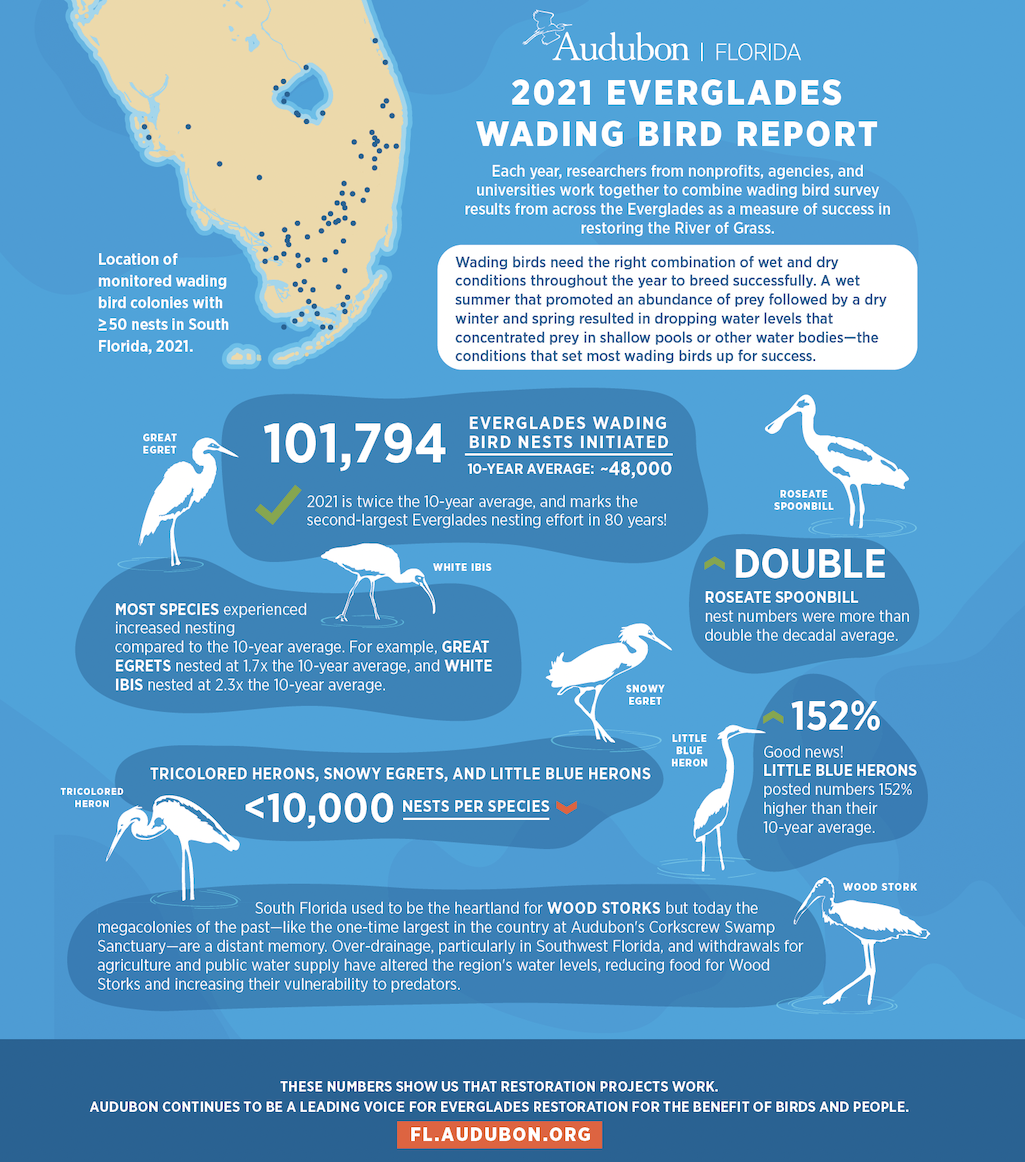
2021 was a very good year for wading bird nesting in the Everglades/Audubon Photography Awards, Lisa Willnow
Editor's note: Erika Zambello is the communications director for Audubon Florida, and a member of the National Parks Traveler's board of directors. Audubon Florida staff contributed data and analysis to the report and Audubon’s summary.
Herons, egrets, ibis, spoonbills, storks — Florida’s iconic wading birds tell us if the Everglades ecosystem is healthy, and if restoration efforts are improving conditions in the River of Grass. In 2021, the Everglades experienced its second-highest nesting effort for many wading bird species in 80 years!
Wading birds need the right combination of wet and dry conditions throughout the year to breed successfully. A wet summer that promoted high prey production followed by a dry winter and spring resulted in dropping water levels that concentrated prey in shallow pools or other water bodies—the recipe for a successful breeding season. When prey is concentrated, wading birds expend less energy to feed their voracious chicks. As a result, scientists counted 101,794 nests initiated by wading birds in the 2021 nesting season—more than twice the 10-year average of 48,000 nests.
“Well-timed rainfall in the Central Everglades resulted in big nesting efforts for the region's iconic wading birds—proof that if we get the water right, the birds will respond. The data tells us that if we restore habitats, birds can succeed, and it is our duty to give them a fighting chance,” says Kelly Cox, Audubon Florida’s director of Everglades Policy. “Thanks to extreme rainfall, Wood Storks shared in these successes—an outlier, as they still struggle in most years to raise chicks to fledging, especially in southwest Florida's over-drained landscape."

Key highlights:
- Thirty-four percent of nests were in coastal Everglades National Park. This is an increase of 9 percent from 2020, edging closer to the restoration target of 50 percent. This is a significant improvement over the 2-10 percent that occurred in these coastal habitats in the 1990s and 2000s, respectively.
- Everglades National Park continued its trend of increasing nesting efforts (35,292 nests) in 2021, representing the seventh season in the last 20 years in which nest numbers have exceeded 10,000 nests. In addition, the White Ibis colony reached super colony size for only the second time since the 1940s, which is great news. Other than one Great Egret colony site, most colonial wading birds had successful seasons, with four colonies benchmarking more than 1,000 nests, an increase from 2020, which had only three colonies with mroe than 1,000 nests.
- Roseate Spoonbill nesting remains alarmingly low in Florida Bay, but higher overall. In 2021, nest initiation timing was slightly improved with most egg laying occurring in December and early January. Despite poor numbers in Florida Bay, the 1,219 Roseate Spoonbill nests observed throughout the Everglades were nearly twice that of the 10-year average and almost equal to the peak number of nests ever reported for Florida Bay (1,256) in the 1970s.
- The number of nests for small Egretta heron species continues to be lower than historical counts. These nests still remain decidedly lower than the estimated 10,000 pairs in South Florida’s past. Still, Tricolored Herons produced 2,301 nests in 2021, a 104 percent increase over the 10-year average, Snowy Egrets produced 4,426 nests, a 55 percent increase over the 10-year average, while Little Blue Herons produced 996 nests, a 152 percent increase over the 10-year average.
- Many Wood Storks initiated nesting late. The Comprehensive Everglades Restoration Plan target time frame for Wood Stork nest initiation is November/ December. Like 2020, they once again began nest initiation in mid-late January 2021, though nest initiation was spread out with some nesting beginning in February and March. Delays in nest initiation are caused by the loss or degradation of shallow, seasonal wetlands—the wetlands available for foraging early in the nesting season. Wood Storks must start nesting early enough in the nesting season to fledge their chicks before summer rains arrive, as rising water levels prohibit them from collecting enough prey to feed their chicks. De-listing Wood Storks and removing their protections under the Endangered Species Act would be premature. Wood Stork recovery in Southwest Florida is critical for increasing their population across the Everglades.
Audubon Florida recommends continued investment in longstanding Everglades restoration efforts to support future success of wading birds.


